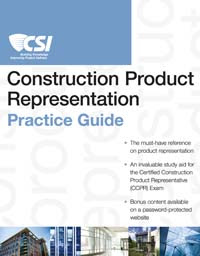Feb. 14 FREE Webinar: Inside the Mind of a Specifier -- 8 Things Product Representatives Should Know About How A Specifier Works
Ever wonder how decisions are made about which products are included
in a project specification? Want to know how you can help make project
specifications better? Want guidance on what to include in meetings or
presentations with architects and specifiers? This course, from the
point of view of one independent architectural specifications
consultant, is for product representatives who want to work better with
specifiers, and better understand what makes some specifiers "tick." Our
speaker is Liz O'Sullivan, CSI, CCS, CCCA. This webinar is FREE to CSI members and members of CSI's Product Representation Practice Group.
Register now!
 20 Sessions Designed for Construction Product Representatives
20 Sessions Designed for Construction Product Representatives
The Product Representative Academy (March 27-29, Indianapolis)
How many times have you heard a marketing expert speak and thought,
"That's not true in construction"? Construction product representatives
make complex sales and create long-term relationships. CSI's Product
Representative Academy was designed by product representatives working
in the construction community to train representatives in this
industry. At this event, you'll talk to experienced representatives,
specifiers, and contract administrators about the roles and
responsibilities of each member of the project team, and best practices
for presenting products and supporting the design and construction
teams. The 20 sessions offered for product representatives this year
include:
- Good, Bad, & Ugly Specifications: Dealing With Design Professionals When Their Spec is Unclear, Incomplete, & Incorrect
- Delivering More Than the Meal: Building the Best Box Lunch Presentation
- How to Submit the Ultimate Substitution Request
- Blueprints to BIM - How Can I Navigate this Environment?
- Bringing Home Projects from Trade Shows and Conventions
See a complete list of sessions, or register now at
www.csinet.org/academies.
NEW Trusted Advisor Workshop (Denver, May 16)
What does it take to be a trusted advisor? Regardless of what
product you represent, much of your success will be determined by: your
skills, training, and understanding of construction; your ability to
manage your network and resources; and your integrity and
trustworthiness in the eyes of the community you work in. We'll address
all three of these areas during CSI's Trusted Advisors Workshop. Topics
will include: Ethics, Integrity, and Trust; Developing and Managing a
Network; Identifying and Managing Your Representation Resources; and
Know the Construction Process and the Players.
Learn more.
Online Right Now
Watch "Tips From Product Representation Experts" on YouTubeCSI has posted a recording of the webinar "Tips from Product Representation Experts" on the Institute's YouTube channel.
Watch it or
download the slides, or
read notes from the session that were tweeted.
Join the Product Representative Discussions in CSI's LinkedIn GroupEach week, CSI posts a question about product representation in its LinkedIn Group. Recent discussions include:
- What
is the preferred way to approach Specification Writers/Architectures as
a vendor in order to have them specify your product or add you as
vendor?
- Advice for Product Representatives on Subcontractors?
CSI
members are let into the group once CSI has checked their membership
status. Non-members are also allowed in the group case by case.
Join the group!
Products & Programs
Product Representative Practice Guide Available

The must-have reference on construction product representation and the essential study aid for the
Certified Construction Product Representation (CCPR)
Exam, the CSI Construction Product Representation Practice Guide is
an authoritative resource for the principles and best practices of
effective construction product representation. This easy-to-follow guide
covers a number of topics, including: the construction process and the
roles a construction product representative can play in it; information
that clients require to select appropriate products to meet project
requirements; and the role a product representative plays in an
Integrated Product Delivery (IPD) workflow. Member price $68/Non-member
price $85.
Learn more or order it. Corporate Partners Program
Building product manufacturers are using CSI's Corporate Partner
Program to increase their exposure in the commercial construction
industry. Each partnership is customized to the company's strategic
business goals and objectives. Partner organizations enjoy value pricing
on membership, education and certification, sponsorship and recognition
opportunities, and increased visibility through CSI's network of
construction professionals. See all 50+ partners and learn more at
www.csinet.org/CorporatePartners.
Compliant Document Review (CDR) Program for Guide Specifications

CSI's
CDR Program
for guide specifications is a structured program for reviewing
manufacturer guide specifications for conformance with CSI formats and
guidelines. Through the program, manufacturers can have CSI certified
experts review their guide specifications for conformance with CSI
formats and guidelines. Guide specifications that conform are posted at
www.csinet.org/CDR
and may use the CDR logo. Guide specifications are reviewed for
their conformance with MasterFormat, SectionFormat and PageFormat. Other
good specification practices as identified in CSI's Practice Guides are
also considered.
Learn more.
CCPRs: Look for Education That Supports Your Renewal
CSI requires professionals who are renewing a Certified Construction
Product Representative (CCPR) certification to have participated in
continuing education related to product representation. Specifically,
"50% of the topics must be related to the professional practice of the
certification being renewed, as defined by the CSI Practice Guide."
That's 12 hours of training! The aforementioned Product Representation
Experts Webinar, Product Representative Academy, and Trusted Advisor
Seminar will provide Professional Development Hours (PDHs) appropriate
for renewing CCPR certifications. Select events at the Master Specifiers
Retreat may also qualify. Learn more about renewal requirements
at
www.csinet.org/CCPR, and watch for CSI events that provide PDHs related to your certification.

















 What do presenters do right or wrong during box lunch presentations?
Hear it from an Architect that has sat through many presentations and a
product representative that has provided thousands of programs. Learn
the important steps to make your lunch and learn educational session
more productive, effective and beneficial to your architectural
audience. Discover new ways to stimulate interest in your product,
methods to improve retention for adult learners, and techniques to make
you their first call for product or system consulting.
What do presenters do right or wrong during box lunch presentations?
Hear it from an Architect that has sat through many presentations and a
product representative that has provided thousands of programs. Learn
the important steps to make your lunch and learn educational session
more productive, effective and beneficial to your architectural
audience. Discover new ways to stimulate interest in your product,
methods to improve retention for adult learners, and techniques to make
you their first call for product or system consulting.
Finally, I issued a statement that the products were not allowed under the terms of the specification section. Should the hardware supplier wish request that these products be used they must request a substitution, and I would have to see the cost back to the owner for this substitution. The contractor said that he could put together the data needed for a substitution review, but that the cost savings was already in the bid price. I responded no it is NOT. The bid price reflects the specified products. Your request for substitution will have to be a cost back to the owner. Guess what I got the specified products. This required me to educate my owner and I had to hold firm in the face of an frustrated, and irritated contractor. If we as the architects, perform lazy, the contractor will seize the opportunity. When that happens, the good products reps get chewed up. I do not want our trusted advisors chewed-up.
Here is my own answer to the question:
Thanks, everyone, for the thoughtful answers to my questions. I spoke with my client today and recommended against his initiation of substitutions during bidding. I explained it to him this way:
"If you approach the architect during bidding, you might get named in an addendum, but that will not help your long term cause. Bidding is a rushed, chaotic process, and most of the team that put together the contract documents will have moved on to other projects as soon as the job is put out to bid. This means that most substitution requests are reviewed by just one or two members of the project team. They might say 'yes', but that information does not become part of the institutional memory of the firm. Instead, I recommend working with the office so they understand the benefits of the product and you get buy-in from the project architects, draftsmen, specifier, engineer, cost estimator, and other members of the team. Otherwise, they will simply fall back onto old habits, cut and paste old details, reuse existing spec masters, and you will have to fight for another substitution on the next project."
I suggested a sales-oriented approach of working with sub-contractors to submit substitutions after contracts are issued. This works to my client's advantage due to the reduced labor associated with his product.
In tandem, I recommended a business-development goal of working with architects to show how to bring their standard details and spec masters into compliance with best industry practices.
One of my mentors was a forensic engineer. He told me that most of the product failures he had investigated were substitutions that were rushed through without adequate research, coordination, or documentation.